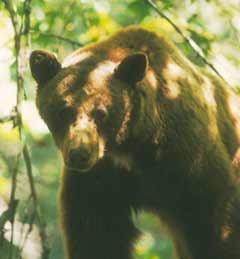Wildlife
The Sierra Nevada is one of the largest undeveloped land areas in the United States, providing vast amounts of natural wildlife habitat. Some of the finest wildlife watching in the state can be enjoyed while hiking in the Sierra Nevada.
If you see a wild animal - especially bear - exercise caution. Do not approach the animal - remember, it is a wild animal! If you're in your car and want to observe the animal, pull over carefully (watch for other cars and pedestrians) and stay in your car.
Bears in the Sierra Nevada have learned how easy it can be to take food from humans. To protect both the bears and humans, the management agencies have established rules for food storage. It is important for you to check with the managment agency regarding the rules where you plan to hike.
Deer are seldom dangerous to humans, but you should remember that they have sharp hooves so you don't want to give them a reason or opportunity to kick at you. In the National Parks, because they are protected from hunting, deer can become downright friendly and pesky around camp.
While a few other large animals such as bighorn sheep, coyotes and mountain lions roam the Sierra Nevada you are unlikely to see them. Smaller animals such as chipmunks, ground squirrels, marmots, mice and others are often observed and will check out your camp for food.
Viewing Ethics and Responsibilities.
Most people who spend any time outdoors care a great deal about wildlife and wildlife habitat. Unfortunately, even the innocent act of observing wildlife can have a great impact on the animal if it is not done properly. Observing a few guidelines will help us put the needs and safety of wildlife first, to conserve wildlife and habitats and respect the rights of others.
- Enjoy wildlife from a distance: The goal of successful wildlife watching is to see animals without interrupting their normal behavior. Wildlife send clear signals you are too close when they stop feeding and raise their head sharply, move away, change direction of travel or appear nervous or aggressive. These disturbances may result in an animal abandoning its young, injuring itself as it tries to escape, quit feeding at a time of critical energy need or displaying aggressive behavior toward you.
- Don't feed the animals. While it may seem exciting at the time to have an animal eat out your hand, there are potential serious consequences. Some animals that become accustomed to handouts may lose their natural fear of humans. This may cause them to become aggressive with visitors who refuse to feed them. This situation may lead to human injury, which in turn usually means the death of the animal involved. Human food does not meet the living requirements for many animals and may seriously harm them. Animals who have become accustomed to handouts may be faced with starvation once that food source is no longer available.
- Never chase or harass animals. In some cases, valuable energy resources needed for survival are used when animals are chased. Your wildlife viewing experience will be more successful if you leave your pets at home.
- Don't pick up orphaned or sick animals. Wild animals rarely abandon their young. In most cases the adults are nearby, waiting for visitors to leave before they return. If an animal appears to be sick or injured, behaves oddly or appears to be tame, leave it alone. There are a number of wildlife diseases including rabies that can affect humans.
- Honor the rights of private landowners. Always ask permission before entering private property. Leave no trace that you have been there.
- Respect the rights of other recreationists at a site. Be considerate when approaching wildlife that is already being viewed. A loud noise or quick movement may spoil the experience for everyone. Remember -- you share the woods with many other recreationists including hikers, snowmobilers, mountain bikers and hunters. Most public lands are open to hunting and fishing.
